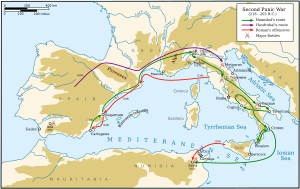Battle of Carteia facts for kids
Quick facts for kids Battle of Carteia |
|||||||
|---|---|---|---|---|---|---|---|
| Part of the Second Punic War | |||||||
 Map of the Second Punic War |
|||||||
|
|||||||
| Belligerents | |||||||
| Commanders and leaders | |||||||
| Strength | |||||||
| Unknown | 6,000 soldiers (including 4,000 Celtiberians) 700 Cavalry |
||||||
The Battle of Carteia was an important fight during the Second Punic War. It happened in 206 BC between the armies of Carthage and the Roman Republic. This battle is sometimes called the "Battle of the Guadalquivir." However, that name wasn't used back then. The river got its name, "Guadalquivir," much later from Arabic words. Carthaginian soldiers were led by Hanno. The Roman army was commanded by Lucius Marcius Septimus. The Romans won this battle.
Why the Battle Happened
After the Carthaginians lost the Battle of Ilipa, many local people called the Turdetani joined the Romans. The Carthaginian generals, Hasdrubal Gisco and Mago Barca, were stuck with their troops in Gadir. This city protected them from Roman attacks.
Later, some groups rebelled against the Romans. To help deal with this, the Roman general Publius Cornelius Scipio Africanus sent Lucius Marcius Septimus. Marcius took a small, fast group of soldiers down the Guadalquivir River. They were heading to where the river meets the sea.
There, the Romans met a Carthaginian leader named Hanno. Hanno was trying to hire new soldiers, called Celtiberian mercenaries. He was doing this for Mago Barca, because Mago and another Carthaginian general had just lost an army.
The Fight Begins
Hanno's army had 700 horsemen and 6,000 foot soldiers. About 4,000 of these foot soldiers were Celtiberian warriors. The rest were from Africa. Lucius Marcius Septimus attacked Hanno's forces. The Romans managed to surround the Carthaginians on a hill.
The Celtiberian mercenaries quickly started talking with Marcius. Marcius asked Hanno to hand over any soldiers who had left their armies or any prisoners. He also asked for money. He said that if they did this, they could make a deal.
Once the mercenaries came down from the hill, Marcius gave his final order. He told them to give up their weapons and go back to their homes.
A Brave Stand
However, this last demand made the Celtiberians very angry. In their culture, it was better to die than to give up their weapons. They refused to follow the order and immediately started fighting again.
The Carthaginian forces fought bravely. But in the end, more than half of their soldiers were killed. The remaining soldiers managed to escape.
What Happened Next
The Celtiberian and African fighters who escaped ran towards Mago Barca's army. Mago had arrived on the coast with 60 ships to pick up the survivors. After this battle, Carthage only controlled the city of Gadir in that area.
Mago Barca put the rest of his army on ships. He tried to take back Cartago Nova, a city the Romans now held. Mago's army was only a few thousand strong. They landed and tried to attack the city. But the Roman forces pushed them back in a fight known as the Battle of Cartagena in 206 BC.
Mago Barca returned to Gadir after his defeat. He found that the people of Gadir had closed their gates to his army. They had started talking with the Romans instead. Soon after, Mago left Gadir. He sailed to the Balearic Islands and spent the winter there. The next year, he sailed north to Italy. He hoped to start a rebellion among the Ligures people there.
See also
 In Spanish: Batalla del Guadalquivir para niños
In Spanish: Batalla del Guadalquivir para niños

